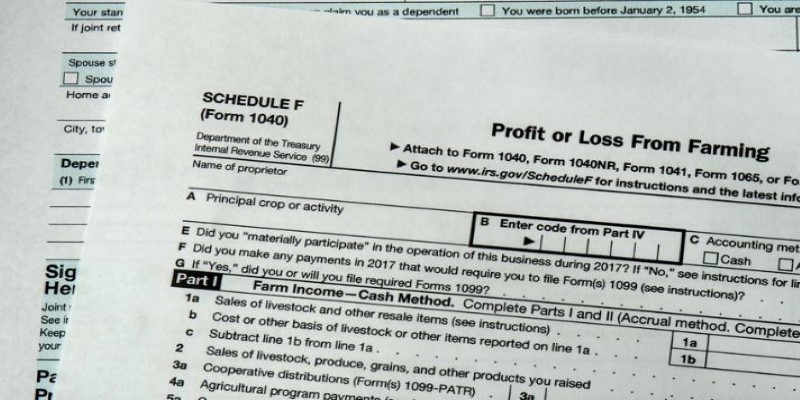Filing Schedule F: Everything Farmers Need to Know About Profit and Loss Reporting
Dec 09, 2024 By Georgia Vincent
Tax season can be overwhelming for farmers, but understanding Schedule F: Profit or Loss From Farming can simplify the process. This form is specifically designed for farmers to report income and expenses from farming activities.

Whether or not you're a first-time farmer at tax, knowing how Schedule F works can get you up to speed and sure on how to comply with laws in taxation as well as maximize the deduction. From defining what the form is to how to make use of it, let's break it down and make filing easier for you.
What Is Schedule F?
Schedule F is a tax form used by farmers reporting income as well as expenses from farming activities. An individual income tax return, Form 1040, is required to report this income while showing whether there is a profit or a loss. Farmers' finances are often confusing since income arises from various sectors, namely crop sales and livestock sales, among others, and government incentives in farming. Schedule F helps farmers list sources of income and claim some deductions regarding farm-related items such as seeds, equipment, labor, and maintenance. Farmers have to fill out Schedule F if farming is a primary source of income or if they want to deduct farm expenses so that they can separate personal and business costs for proper tax reporting.
Key Components of Schedule F
Schedule F has several sections where farmers write down different types of income and expenses. Here is the breakdown of some of the most important sections:
Part I Income
This section of the form reports your gross farming income. Gross income includes all proceeds realized from crops, livestock, and other agriculture-related commodities. Included in this list is also agricultural program income as well as other related income such as subsidies or grants.
Part II Expenses
Part II lists all of the expenses incurred in running your farm. These can be sub-classified into several different types of expenses, including but not limited to:
- Feed, seed, and fertilizer costs
- Labor costs (wages and salaries for farmworkers)
- Equipment depreciation
- Interest paid on farm loans
- Insurance premiums for farm property
The IRS allows farmers to deduct these expenses to help reduce taxable income, which can result in a lower tax bill.
Part III Farm Rental Income or Loss

If you rent out your farm or any land to others, you must report this rental income in this section. If you incur any losses from rental agreements, they can also be reported here, reducing your taxable income.
Part IV Other Information
This section asks for additional details about your farming activities, such as whether you were involved in any cooperative arrangements or if you received any government payments or subsidies. The information in this part is used to give a fuller picture of your farm's financial situation.
How to Use Schedule F for Your Farming Business?
Filing Schedule F might seem complicated at first, but once you understand the structure, it becomes a lot more manageable. Heres a step-by-step guide to help you through the process:
Step 1: Gather Your Farms Financial Records
Before you can fill out Schedule F, you need to gather all the records for your farms income and expenses. This includes receipts, invoices, bank statements, and records of sales or subsidies. Having everything in one place will make the process smoother.
Step 2: Determine Your Income
Start by adding up all the income you received from farming. This includes income from crops, livestock, and any government subsidies or grants. Make sure you report all sources of income accurately to avoid any issues later on.
Step 3: Calculate Your Expenses
Next, take a look at your farming-related expenses. This is where you can deduct costs like fuel, repairs, and wages for farm employees. The IRS allows you to deduct both variable costs (like feed and fertilizer) and fixed costs (such as equipment depreciation or interest on loans).
Step 4: Fill Out the Form
Now, youre ready to fill out Schedule F. Start with Part I to report your income, and then move on to Part II to list your expenses. Use Part III to report any rental income or losses, and dont forget Part IV for additional information.
Step 5: Attach the Form to Your 1040

Once Schedule F is filled out, attach it to your standard individual tax return (Form 1040). You will then calculate your overall tax liability based on your net farm profit or loss, which is the difference between your income and your expenses.
Benefits and Drawbacks of Filing Schedule F
Explore the benefits and drawbacks of filing Schedule F to help you make informed decisions about managing farming taxes.
Benefits
Tax Deductions for Farming Expenses: Farmers can deduct a wide range of expenses, such as feed, labor, and equipment depreciation, reducing their taxable income and lowering their overall tax bill.
Opportunity to Report Farm Losses: If your farm incurs a loss, you can deduct it from other income, potentially lowering your overall tax liability, especially during tough years.
Increased Accuracy in Financial Reporting: Filing Schedule F allows farmers to clearly separate personal and business expenses, ensuring more accurate tax reporting and reducing the risk of mistakes.
Drawbacks
The complexity of the Form: Schedule F can be complicated for farmers with diverse income streams. It requires careful categorization of expenses and income and potentially necessitates professional help to ensure accurate filing.
Record-Keeping Requirements: For Schedule F, maintaining organized records of all income and expenses is essential, which can be a challenge for farmers juggling various operational tasks.
Potential for Audit: Filing Schedule F can increase the likelihood of an IRS audit, especially if your farm shows continuous losses or if there are discrepancies in your reported income or expenses.
Conclusion
Schedule F is an essential form for farmers to report their income, expenses, and profits or losses from farming activities. It offers various deductions that can significantly reduce your taxable income, helping you save money on taxes. While the process of filing might seem daunting at first, once you understand the form and gather your financial records, youll be able to complete it with confidence. Always remember to keep accurate records and seek professional help if needed to ensure that youre maximizing your tax benefits and avoiding common mistakes.

Triston Martin Nov 21, 2023
What Does Annual Income Mean for Credit Cards?

Pamela Andrew Dec 06, 2024
Exchange Rates: What They Are and How They Work

Georgia Vincent Dec 09, 2024
Filing Schedule F: Everything Farmers Need to Know About Profit and Loss Reporting

Susan Kelly Dec 11, 2023
Love Gone Wrong: Navigating the World of Romance Scams

Susan Kelly Nov 09, 2023
Investing in a Roth IRA or Mutual Funds

Triston Martin Dec 09, 2024